-
Engine5.0L SC V8
-
Power510 HP / 461 LB-FT
-
Transmission8-Speed Auto
-
0-60 Time5.1 Second
-
Top Speed140 MPH
-
DrivetrainFour-Wheel Drive
-
Curb Weight4,850 LBS
-
Towing7,716 LBS
-
Seating2+3
-
Cargo32.1 / 71.7 CU-FT
-
MPG13 City / 19 HWY
Focus on the word "it" in the first part of that demand, though, and one can begin to find clarity. When they say "Don't change it," that isn't a command to leave everything untouched on the 42-year-old SUV franchise that can simultaneously rule the farm and the Bolivian highlands and a refugee camp and the vogue enclaves of any national capital. They mean don't change the 'Range Roverness' of it, the feeling that it's penthouse automotive luxury – a donked-out Rolls-Royce if you will, a Phantom on thirty-sixes but without the rapper/kingpin connotations. Beyond that comes the knowledge that if you want to get from Los Angeles to Miami in your Range Rover, you can take the straight shot over the I-10 freeway or a slight detour through the Canadian tundra. And it's still the only SUV extant that will have the driver looking for buttons with the icons for serfs or footmen upon arrival (because you can't be expected to have to do things yourself, can you?).
That feeling remains in the 2013 Range Rover. And the latest generation is better. So there's the prime directive accomplished. Furthermore, it is so capable that it's not wrong to call this the Super Star Destroyer of SUVs.
It does, however, look a little different.
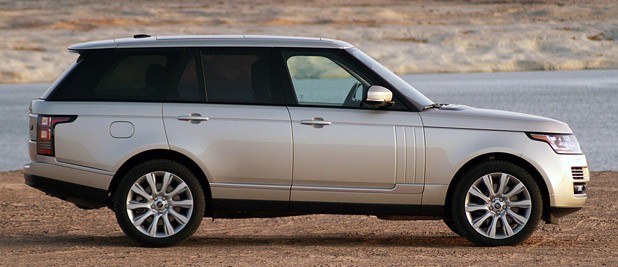
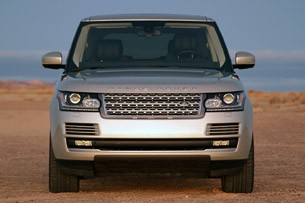
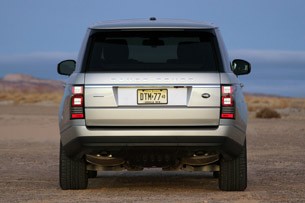
It is just this side of absurd to discuss the off-road chops of a Range Rover. Yet we would be remiss to omit a mention since the engineers have put so much time into improving the latest generation's dirt-duty capability, and the Range Rover really can put most of the Earth's terrain in a tap-out chokehold. On the other hand, it's a bit like talking about what kind of space suit you'd wear if you were going to skydive from 120,000 feet above the surface of the Earth – only one in seven billion people is actually going to do it. And we know from experience that when you pull up to a valet in a newer Range Rover filthy from off-roading, the mute disgust of onlookers says, "You're a child abuser, and I can't wait to report you."
In short, Land Rover naturally didn't make its flagship vehicle any worse. There's permanent four-wheel drive via a two-speed transfer case, a 50/50 torque split front-to-rear, the ability to shift between low and high ranges at up to 37 miles per hour and an optional locking rear differential on the Supercharged trim.The Range Rover really can put most of the Earth's terrain in a tap-out chokehold.
Ducted air intakes have moved to a position above the front wheel arches and under the hood lip to increase wading depth by 7.8 inches to 35.4 inches. The newest evolution of Rover's Terrain Response System, snazzily called Terrain Response System 2, has an Auto setting that uses sensors to detect the surface conditions and will automatically swap between any of its five settings: General, Grass/Gravel/Snow, Mud/Ruts, Sand and Rock Crawl. It also has more processing power, so it reacts more quickly to changing terrain and it can recommend settings for improved performance.
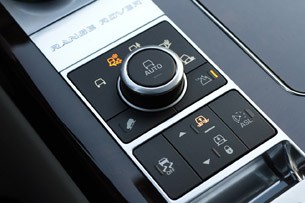
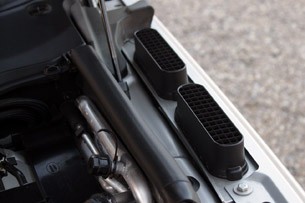
There is more wheel travel, 10.2 inches in front and 12.2 inches in back, and better approach and departure angles. On that note, the Supercharged trim gets the same kind of exhaust as the base and HSE trims, so they don't suffer decreased departure angles because of straight exhaust finishers. Off-road ground clearance rises to 11.9 inches and there's another height step included in the off-road air suspension's settings: the SUV will rise 1.6 inches in the first setting and another 1.35 inches in its taller station. A smooth underfloor protects components and improves fuel economy. That initial setting can now be used at speeds up to 50 mph – previously the Range Rover would descend to on-road height at 31 mph.
Not enough? Well that's when the boffins hurl their Scrabble tiles at you, the new Range Rover being fitted with HDC (Hill Descent Control), GRC (Gradient Release Control), HSA (Hill Start Assist), DSC (Dynamic Stability Control), ETC (Electronic Traction Control) and RSC (Roll Stability Control).The effect of aluminum is a 700-pound weight savings.
The marquee and more relevant upgrade is the aluminum unibody construction of pressed, cast, extruded and rolled components. The entire bodyside is a single panel, housing aluminum doors and side intrusion beams, and is attached to front and rear aluminum subframes with the B pillars reinforced with composites. For the US market, the effect is a 700-pound weight savings when comparing Range Rovers with the naturally-aspirated 5.8-liter V8 of the new and last generations.
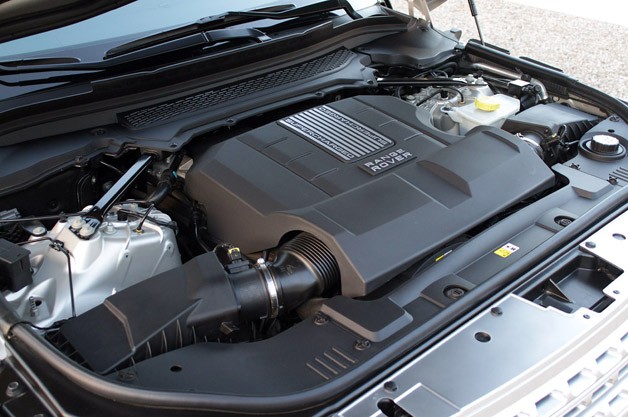
That saves gas and makes this Rover lighter on its feet, the base 5.0-liter, 375-horsepower V8 clocking the 0-60 run in 6.5 seconds, a 0.7-second improvement over the outgoing model. The supercharged, 510-hp V8 goes better by 0.8 seconds over the previous generation, getting to 60 mph in just 5.1 seconds. You'd think you could feel an improvement of nearly one entire second, but it's difficult to tell the difference behind the wheel. Stomp on the gas pedal and the nose tips up like a speedboat, the rear dips like a micturating pup – the effect is, dare we say it, cartoonish – the ZF eight-speed transmission jumps down a couple of cogs and you blast off in the world's fastest luxury loft.
Range Rover says fuel consumption in the 510-hp V8 is improved by nine percent, the Monroney in the one we drove citing 13 miles per gallon in the city, 19 mpg on the highway and 15 mpg combined. Estimated EPA ratings for the 385-hp engine are 14 city, 20 highway and 16 combined. The 27.7-gallon tank will keep owners from having to keep a second residence at the Chevron station, but with the average annual household income of Range Rover owners being $515,000, this is an issue that will be filed under "Doesn't Concern Me."The supercharged, 510-hp V8 model gets to 60 mph in just 5.1 seconds.
We found the most pointed benefit of the new aluminum structure is a 1.65-inch extension of the wheelbase that allows a 4.7-inch extension of rear legroom – the tight rear quarters of the previous model was one of the few demerits we gave it. That extra space for your menisci, larger doors and a lower Access Height also mean easier access to the hindquarters. Once seated, you'll find the rear chairs recline and their seatbacks have a heating option.
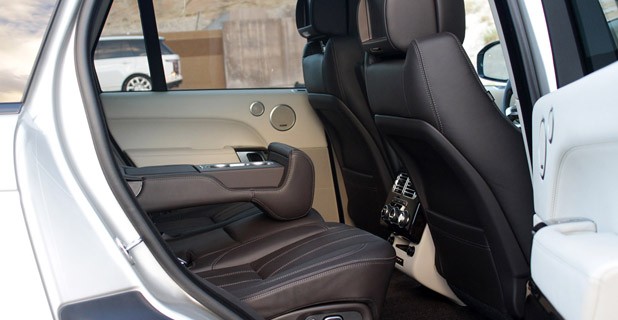
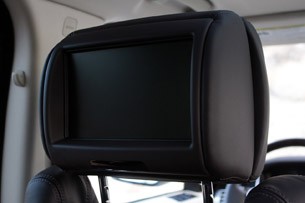
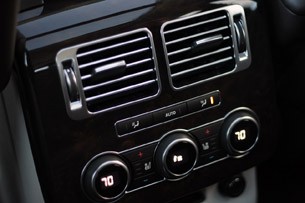
In order to test the new Range Rover, we were beamed into the pioneer-killing canyonlands around Page, Arizona and Kanab, Utah, that latter city a place that Car and Driver officially declared The Middle of Nowhere. Either through a remarkable dedication to road quality or a totally unremarkable lack of traffic, the tarmac surfaces were quite good, and without a previous-generation model on hand for comparison, it was something of a strain to detect the improvements in on-road behavior. The variable ratio and variable feedback electrically assisted power steering was fine, enhanced with Pull/Drift Compensation to correct for crowned roads and soft lock stops for "a cushioned feeling" at full lock. Let's repeat that just in case you missed it: there's a cushioned feeling at full lock. While you glide through your cushy days and quotidian dramas, these are the awesome challenges being tackled by that indomitable, never-say-die tribe of Range Rover engineers.These are the awesome challenges being tackled by that indomitable, never-say-die tribe of Range Rover engineers.
We are willing to believe that a leap in noise, vibration and harshness improvement is in there – the presentation and press kit were full of factoids noting the stiffened chassis points to reduce vibrations, new isolated engine mounts, thinner front air springs fashioned of a low-hysteresis material to improve suppleness, adaptive dynamic suspension that monitors vehicle movements 500 times per second, sound-absorbing foam ducts in the HVAC system and acoustic laminated windshield and door glass to decrease noise.
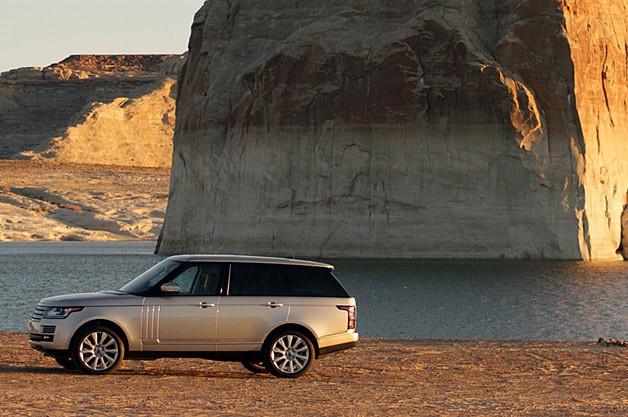
Six-piston, aluminum Brembo front calipers with updated Bosch modulators get the SUV brought to a halt quickly and with more refinement. It isn't hushed; the impressively sized rubber footwear makes itself known, the potent V8 doesn't mind bellowing under acceleration and large side mirrors do create noticeable wind noise at highway speeds, but it's said to be quieter than an Audi A8, so you've got to be listening for all of this. Otherwise, the best we could come up with was, "It feels just like a Range Rover." Which, remember, is a good thing.
Yet it's for these kinds of reasons that we said we could consider the Range Rover the Super Star Destroyer of SUVs. The improvements are everywhere and you'll notice the differences in the overall package, but for the most part, they aren't individually startling. When Darth Vader went from an Imperial Star Destroyer in Star Wars to a Super Star Destroyer in The Empire Strikes Back, we could imagine his hesitation upon being presented an even more giant white isosceles of death. He would say to one of his engineers, "But the one we had could already destroy stars," to which the engineer would reply, as engineers do, "But we made this one out of aluminum. And it has more legroom." What else could Vader say but, "Oh yes, indeed. That is nice," even as he thought to himself, 'but it could already destroy stars.' The 2013 Range Rover is being improved just because we expect it, and just because they can.The 2013 Range Rover is being improved just because we expect it, and just because they can.
The Dynamic Lean Reponse, however, is one of those salient improvements. When you finally locate a corner, active anti-roll bars that can independently operate on the front and rear axles keep the SUV much flatter through turns. You can still get some sway going if you saw at the wheel, but again, you've gotta work for it. Let it settle into a turn and relaxed cornering speeds are higher than you'd think.
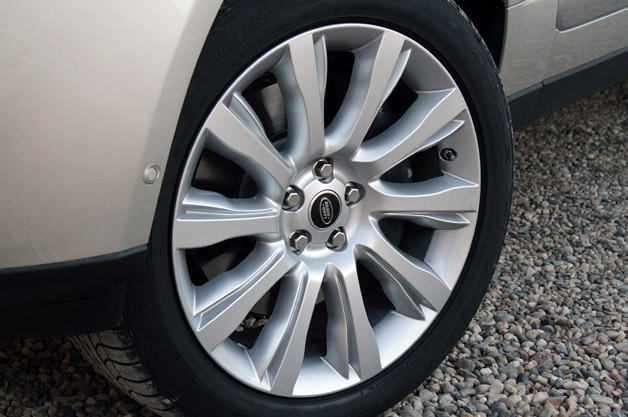
Up to this point we've used up over 1,500 words to explain something that could be summed up in ten: "It feels just like a Range Rover. But it's better."
And now we get to its looks. This is where the fourth generation Range Rover puts a genuine, drafty distance between itself and all other Range Rovers that have come before. The previous three generations have been sparsely decorated rectangles with fast taillights, plus clamshell hoods and floating roofs to drive the point home. Successive models found ways to add more detailing and jewelling to the rectilinear forms, but the forms themselves didn't turn into ornaments.Something about streamlining takes the edge off of its endearing haughtiness.
That's changed. The sacred design elements remain, but the raked front end and faster windscreen, the headlights and taillights that bend around the side of the vehicle with embellished intent, the roof that dips as it slides rearward and tapered sides that give the Range Rover the air of a Range Rover Sport from the back – these things change the equation. It is still stately, but it is less emphatic about it; there's been something royal and visually compelling in the disdain previous Range Rovers have had for aerodynamics, as oblivious to coefficients of drag and fuel economy as any member of Buckingham Palace. Now it cares. That's neither good nor bad in itself, and true, rectangularity isn't the sole definition of stately, else the apotheosis of regality would be a Scion xB. But something about streamlining takes the edge off of its endearing haughtiness.
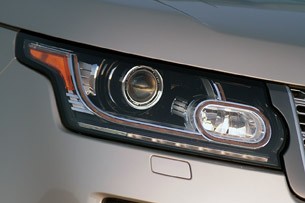
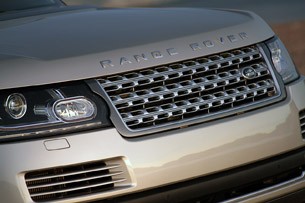
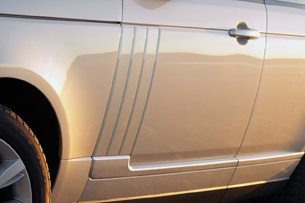
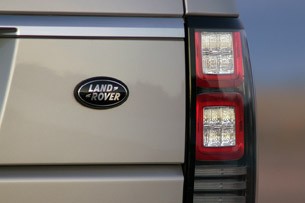
We like the main headlights designed to look like camera lenses, with "Range Rover" and "3000 Lumen" inscribed in a black ring around the main beam. The Tron lightcycle LED DRL pattern, the curved edge of the lights onto the sides we could do without. We could also take a pass on the vent pattern in the front doors; the new air intake location makes a working side vent superfluous, and we were repeatedly told the pressing is an homage to Range Rover history, but that's only generation-three history – the first two models are vent-free, and look none the worse for it. Nevertheless, the 2013 remains a looker, it will not be mistaken for anything else, and that's the main point. Those who are ready to spend anywhere from $83,545 for a base Range Rover to $130,995 for a Range Rover Autobiography will make better judges than us, and we have a feeling they'll approve. Heartily.Buttons and switchgear have been reduced by 50 percent.
Get inside and it's back to 'the same, but better.' There's more headroom, so now you don't have to take off your pith helmet while you drive. Buttons and switchgear have been reduced by 50 percent, but you need to look at a photo of the instrument panel on a 2011 Range Rover Supercharged to realize how shocking the clean-up job has been. The center console is dominated by an eight-inch touchscreen familiar to any Jaguar driver, with hard buttons along each side for quick flips through screens. Beneath that are climate control switches with illuminated readouts that a child could operate. The bouquet of buttons on the steering wheel is a bit much at first, but you'll get the hang of them within a few miles.
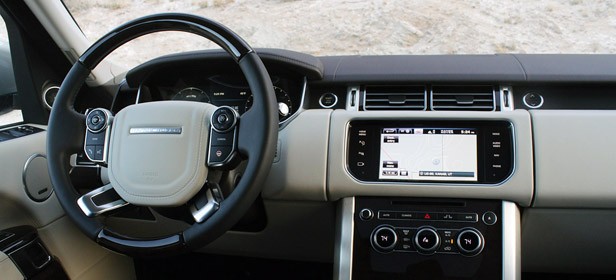
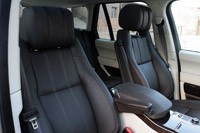

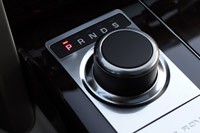
A reconfigurable, 12.3-inch TFT display serves as the gauge cluster, its dials visible in almost all conditions save for when the sun is shining low through the panoramic roof; you can always see the tips of the needles and the outline of the gauges, but the inner details get washed out. Speaking of that panoramic roof, it's the largest ever fitted to a Range Rover.
Everywhere else is "How much luxury do you require, Sire?" Three-zone climate control comes standard, four-zone is an option. The rear seats recline in bench form, or you can get power, individually reclining rear seats with memory and massaging functions on the Executive Package for the Autobiography. The upper and lower sections of the split rear tailgate are now power operated and can be controlled by the buttons on the gates, by the keyfob or with a switch to the lower left of the steering wheel. Three available Meridian sound systems are topped by a 1,700-watt, 29-speaker tsunami of three-dimensional sound. The headliner can be in one of three colors, the floating roof can now be specced in a contrasting color, there are three wood veneers available at launch and more on the way, 17 interior "color themes" and a total of 37 exterior paint finishes on offer.There are three wood veneers available at launch and more on the way, 17 interior "color themes" and a total of 37 exterior paint finishes on offer.
Adaptive Cruise Control can bring the vehicle to a stop and take off again with a slight push on the accelerator. Park Assist will put the Range Rover in a space for you. Blind Spot Monitoring, Closing Vehicle Sensing and Intelligent Emergency Braking will help keep you from running into other vehicles. Reverse Traffic Detection and the Surround Camera System will help keep other vehicles from running into you. Those engineers, still not done playing Scrabble, would then like you to have some ETC, EDC, ABS, EBD, EBL, EBA, and CBC – all different acronyms than the ones previously mentioned. It's all in there.
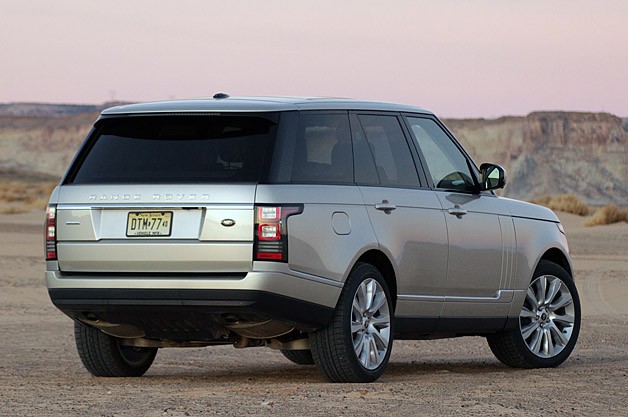
The 2013 Range Rover improves everything over the last generation, and we can unabashedly declare the most ridiculously engineered mass-market SUV in the galaxy to be terrifically capable and fashioned with truly bespoke build techniques. Its largest sales market is New York City. And while there are some terrible roads in NYC, since there's nothing that can't be handled by a yellow Crown Vic, we have to think a Range Rover the most excessive kind of overkill. It has a tow rating of 7,716 pounds. It has 20-way seats, but we know most people only have eight-way bodies. It has five-way massaging function, only lacking "Thai" and "Happy Ending" options. About the only thing Land Rover can do at this point is make the Range Rover more refined and add more gewgaws that people will barely notice or won't use. We will not be surprised if, on the launch for the fifth generation, we're told, "It can detect polonium. The seats have a 'Cure What Ails Me' function. Wading depth is now set to El Niño. Press this button here and it will perform the Heimlich. It comes with a viola."We will not be surprised if, on the launch for the fifth generation, we're told, "It can detect polonium."
What's more, Land Rover barely has to do anything to move it because, as Chris Rock said, "people don't sell drugs, drugs sell themselves." For a certain, growing class of people, this is an "I gotta have it real bad, man..." vehicle.
The best news of all for those buyers is that Land Rover hasn't changed it, but they have made it better.
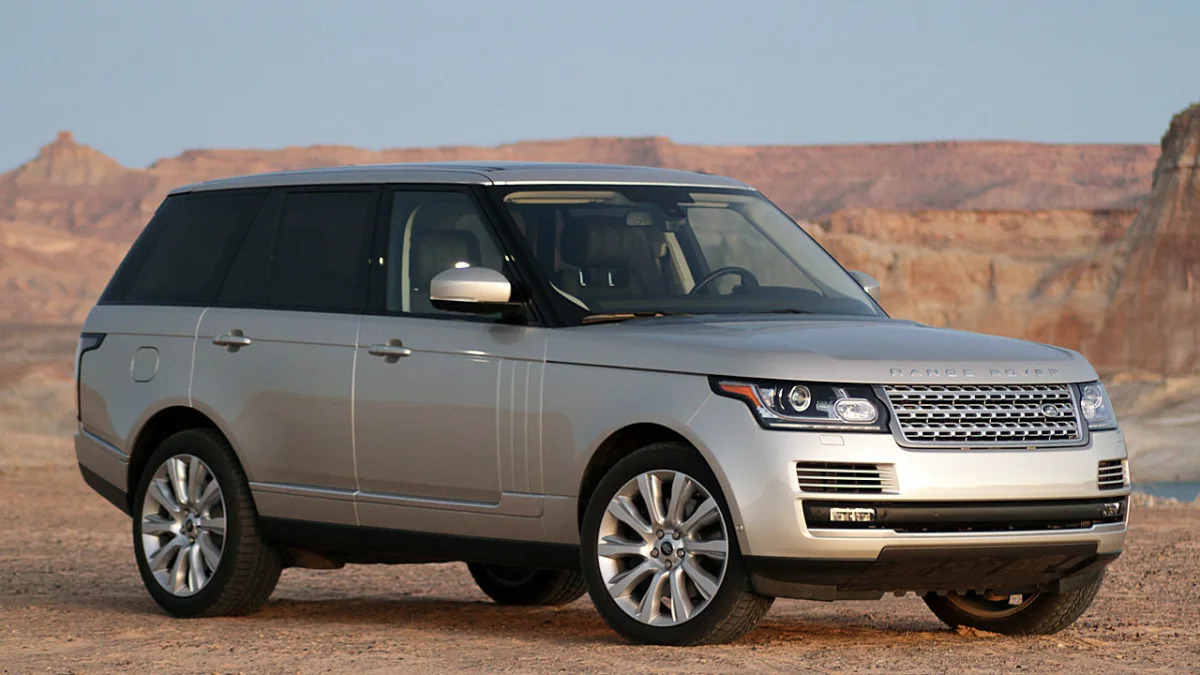









Sign in to post
Please sign in to leave a comment.
Continue